HUD industry research: rapid adoption of OEM HUD in vehicles is under way and Chinese auto brands perform well.
Head-up display (HUD) projects key information onto the transparent media or windshield before the driver for him/her to look down on the cluster and navigation less frequently. So far there have been three types of HUDs mass-produced: C-HUD, W-HUD and AR-HUD.
In 2025, the penetration of OEM HUD in China will outstrip 30%.
According to our statistics, in 2020, 692,000 passenger cars in China packed OEM HUDs, an annualized spurt of 101.2%, with the penetration up to 3.7%, 2.0 percentage points higher than the previous year. In 2021, the penetration of HUD sustains growth and is expected to be 8% or so at the end of the year, compared with nearly 5% in the first half. It is conceivable that the figure will exceed 30% in 2025.
Three reasons stand out. First, larger size and more information displayed make HUD a third screen for an intelligent cockpit, which is accompanied by higher level of vehicle intelligence and upgrade of projection technology. Second, Chinese leading automakers like Great Wall Motor, Geely, Hongqi and NIO quicken their pace of applying HUDs in their vehicles, and lower their prices to the range of RMB100,000 to RMB150,000. Third, the production-ready AR-HUD will boom in the 3 or 5 years to come.
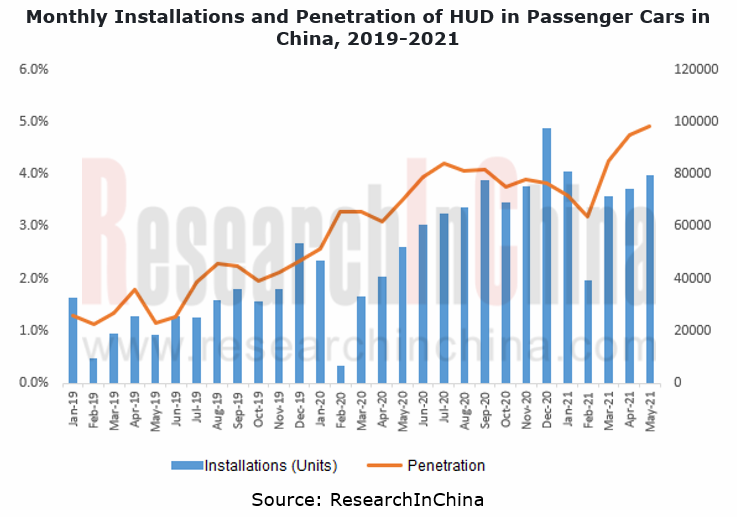
OEMs work hard on W-HUD and push on with increasing installations.
At present, W-HUD as the mainstream solution of automakers is encroaching on the C-HUD market. Our data show that in 2020, W-HUD swept 91.8% of total HUD installations, up 10.2 percentage points year on year. As the technology matures, AR-HUD, which has become available on market in small batches from 2021, will be neck and neck with W-HUD, together driving up HUD installations.
In future, W-HUD will evolve from an optional configuration for high-class vehicles to a standard one for medium & low class. Chinese auto brands play a crucial role in this process. Since 2020, the likes of Hongqi, Haval, Geely, Lynk & Co and Geometry have been the main drivers of W-HUD in China. The prices of HUD-enabled models like Geely Preface, Haval Big Dog and Haval First Love have been lowered to RMB150,000.
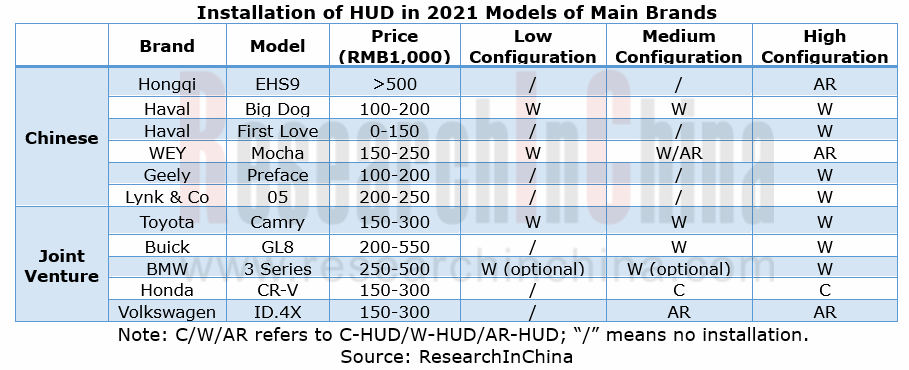
Mass production of AR-HUD starts, and TFT solution becomes the first choice.
AR-HUD displays real road conditions. The combination of ADAS functions such as LKA and ACC provides immersive experience for drivers, which is a future trend for HUD.
In September 2020, Mercedes-Benz S-Class with AR-HUD made a debut, establishing the age of mass-produced AR-HUD. And then models including Audi Q4 e-tron, Volkswagen ID Series, FAW Hongqi and Great Wall WEY have been competing to offer AR-HUD-enabled versions.
In addition, Hyundai Kia, Hyundai Aini Krypton, GAC, Changan Auto and Chery, among others, plan to equip their new cars with AR-HUD. For example, AR-HUD co-developed by GAC and Foryou Group is to be first mounted on a mass-produced model in the fourth quarter of 2021.
Through the lens of solutions, AR-HUDs spawned so far generally use TFT and DLP technologies. By comparison, TFT costs less so Chinese models prefer this technology; despite high cost, DLP technology that works very well finds application in some highly-configured or top-class models (e.g., Mercedes-Benz S-Class with selling price higher than RMB800,000).
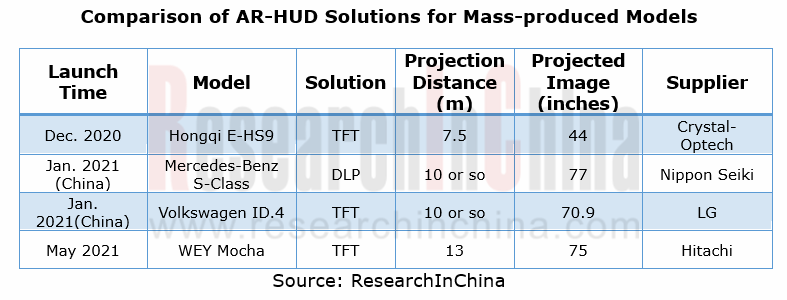
WEY Mocha: launched in May 2021, the model carries AR-HUD which delivers 13m projection distance and 75-inch image where speed, fuel level, distance (to destination), direction, etc. are shown. The device also enhances annotations to lane lines and displays the dynamic distance with other vehicles, with dynamic arrows appearing for guidance when turning or U-turning.
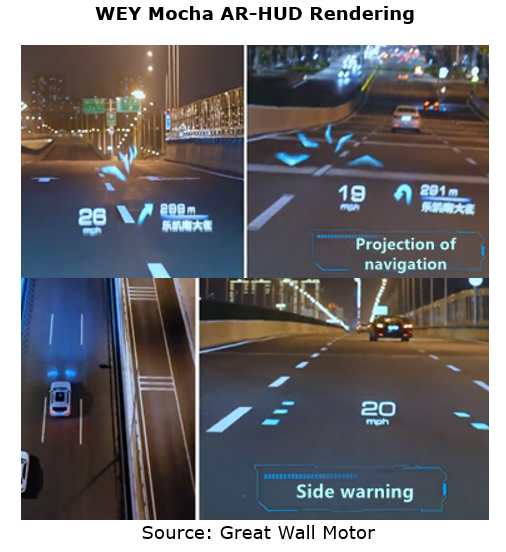
Volkswagen: the automaker has rolled out several AR-HUD-enabled models such as ID.4 and ID.6 since 2021, all of which use TFT projection technology. Differing from WEY Mocha and other China-made cars, these Volkswagen models feature double-layer display design in which the upper layer is AR field where driving assistance information and navigation tips are displayed in the form of dynamic 3D rendering, with virtual image distance (VID) up to 10m and display field diameter of 1.8m (about 70.9 inches); the lower layer is status field displaying speed, navigation, road signs, destination, etc., with VID of 3m.
Things come in pairs. Both Mercedes-Benz and Audi also adopt such display design, which makes images enhanced in much better virtual effects.
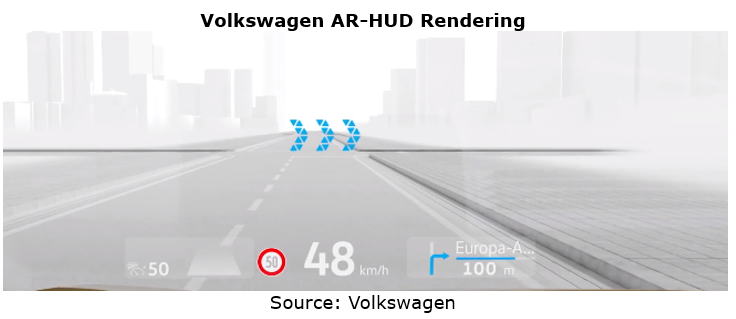
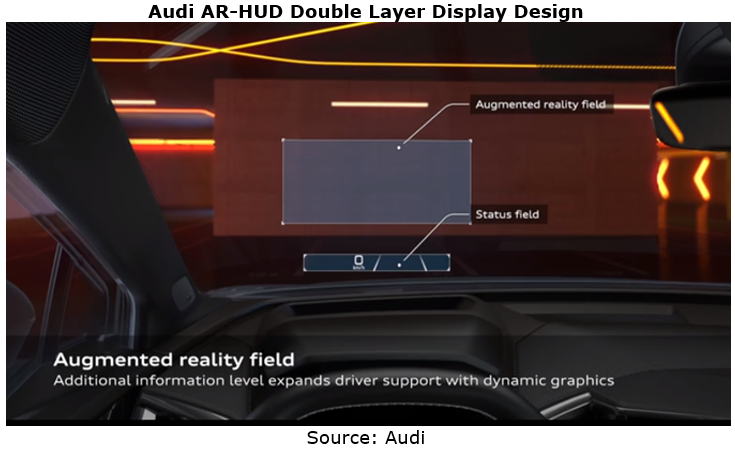
The rising Chinese suppliers pin great hope on AR-HUD.
Nippon Seiki, Denso and Continental have a monopoly on the Chinese HUD market. They target mid- and high-end brands such as BMW, Audi, Mercedes-Benz, Mazda, Toyota, Honda and Buick.
In China, local suppliers like Foryou Multimedia Electronics, Jiangsu New Vision Automotive Electronics and E-Lead Electronic serve domestic automakers including Geely, Hongqi, Great Wall Motor, NIO and Dongfeng Motor.
As AR-HUD comes into being, almost all suppliers gravitate towards it, but local players are more motivated.
Nippon Seiki: the world’s largest HUD supplier boasts annual capacity of nearly 2 million units. In 2020, it was the first one to provide AR-HUD for Mercedes-Benz S-Class. In 2021, it is working hard on construction and layout of HUD production bases in China.
Foryou Multimedia Electronics: as of June 2021, the supplier has shipped a total of 200,000 HUDs which have been used in multiple models of Great Wall Motor, GAC, BAIC, Dongfeng Nissan and Changan Auto. The company has secured designated AR-HUD projects from GAC and others that plan installation in their vehicles in 2021. It is also developing double layer AR-HUD, with the maximum and minimum VID up to 10m and 2.4m, respectively.
Huawei: in April 2021, Huawei unveiled an AR-HUD based on LCOS projection technology, offering 7.5m VID, 13°x 5° FOV and 70-inch image. The device is just 10L much smaller than DLP HUD, and puts projections directly onto the windshield, with no need for special treatment of the windshield.
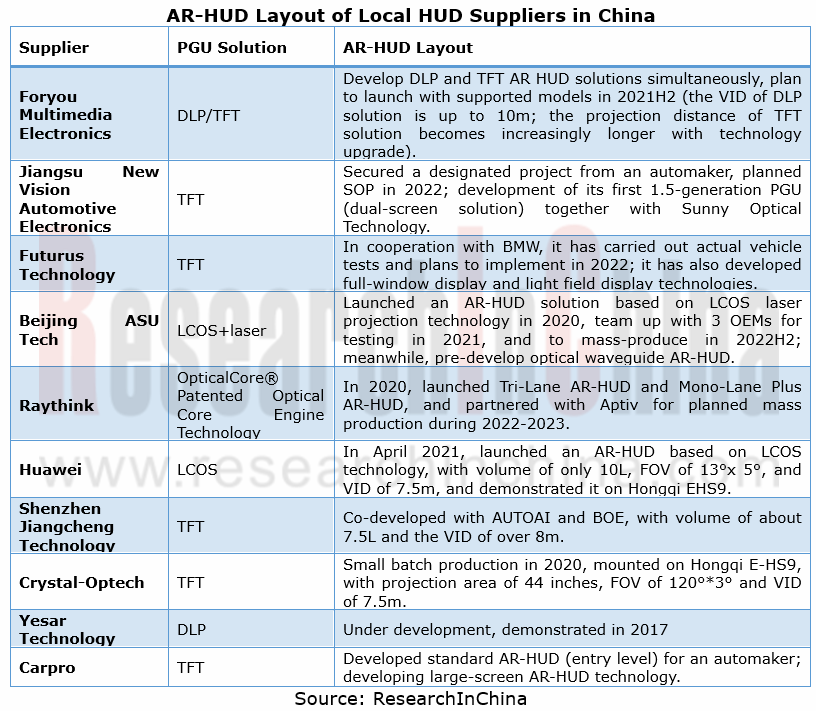
Giants race to deploy new-generation holographic technology.
Current mass-produced AR-HUDs still adopt the geometrical optical projection solution that W-HUD uses, which means an ultra-large aspheric mirror is needed to increase the projection distance (AR-HUD VID is required to be over 10m). Thus the package size is so large that OEMs cannot use.
Holographic technology (optical waveguide, HOE, CGH, etc.) which not only reduces the size of the device but widens FOV has been a hot spot for suppliers and automakers.
In September 2020, DigiLens, an optical waveguide start-up, 18% owned by Continental, introduced its CrystalClear? AR HUD based on DigiLens’ proprietary photopolymer material, with the largest FOV up to 15°x5°, luminance of 12,000 nits and package size of just 5 liters, allowing it to fit into most vehicles and displaying images at infinity.
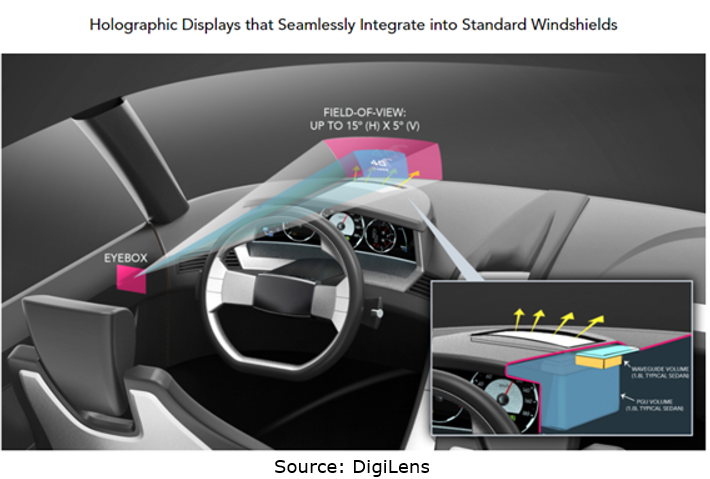
In January 2021, Panasonic together with Envisics rolled out an AR-HUD based on laser holographic technology. Using eye tracking and vibration control technologies, the HUD offers VID up to 10m, FOV of 10°×4°, and image resolution as high as 4K, displaying speed, fuel level, etc. in the near field and navigation in the far field.
Envisics, founded in 2018 and based in the UK, is developing holographic AR-HUD for over ten companies such as Hyundai Mobis, General Motors and SAIC. Its new technology will be the first used in Cadillac’s mass-produced models in 2023.
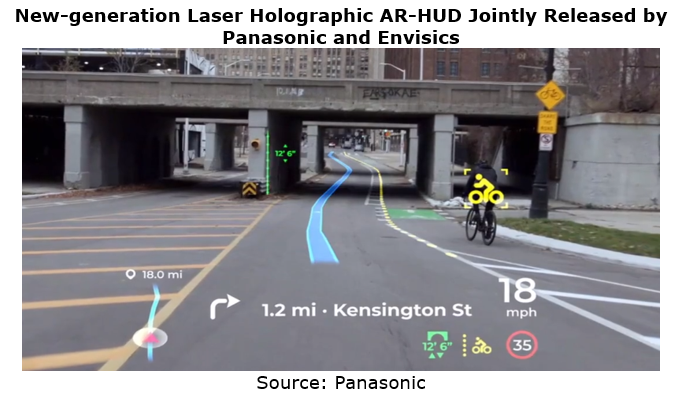
In July 2021, VividQ, a computer-generated holographic technology (CGH) firm, raised USD15 million in its seed funding round led by UTokyo IPC, the venture investment arm for the University of Tokyo. Its holographic technology will be first applied to automotive HUD for OEMs in China in early 2022.
Moreover, Hyundai/Porsche (investing WayRay), Denso/Intel (investing CY Vision) and BAIC (partnering with Sanji Optoelectronics) are deploying holographic technology as well.
CTP, CTC and CTB Integrated Battery Industry Research Report, 2022
Integrated battery research: three trends of CTP, CTC and CTB
Basic concept of CTP, CTC and CTB
The traditional integration method of new energy vehicle power system is CTM, that is, "Cell to Module...
China Driving Recorder Market Research Report, 2022
Driving recorder research: sales volume of passenger cars equipped with OEM DVRs increased by 52.5% year-on-year in 2022 H1
In April 2021, the Ministry of Industry and Information Technology s...
Autonomous Delivery Vehicle Industry Report, 2022
Research on autonomous delivery: the cost declines, and the pace of penetration and deployment in scenarios accelerate.
Autonomous delivery contains outdoor autonomous delivery (including ground-base...
China Autonomous Heavy Truck Industry Report, 2022
Autonomous heavy truck research: entering operation and pre-installed mass production stage, dimension reduction and cost decrease are the industry solution
ResearchInChina released "China Autonomous...
China Smart Parking Industry Report, 2022
Smart parking research: there are 4,000 players, and city-level parking platforms have been established.
Smart parking market shows great potentials, and Baidu, Alibaba, Tencent and Huawei (BATH) hav...
Automotive Head-up Display (HUD) Industry Report, 2022
Automotive HUD research: AR HUD is being largely mounted on vehicles, and local suppliers lead the way. 1. AR HUD is being used widely, with 35,000 vehicles equipped in the first half of 2022.
S...
Intelligent Vehicle E/E Architecture Research Report, 2022
E/E architecture research: 14 key technologies, and innovative layout of 24 OEMsKey technologies of next-generation electronic and electrical architectures (EEA)
The definition of next-generation E/E...
China Automotive Lighting Market Research Report, 2022
Automotive lighting research: the penetration of ambient lights has reached 31%, and intelligent lighting is reshaping the third living space.
Favorable policies and consumption upgrade help automake...
Global and China Automotive IGBT and SiC Research Report, 2022
1. In 2025, China's automotive SiC market will be valued at RMB12.99 billion, sustaining AAGRs of 97.2%.
Silicon carbide (SiC) devices that feature the resistance to high voltage and high frequency ...
Passenger Car Chassis Domain Controller Industry Report, 2022
Chassis domain controller research: full-stack independent development, or open ecosystem route?
Chassis domain consists of transmission, driving, steering and braking systems. Conventional vehicle ...
China Automotive LiDAR Industry Research Report, 2022
LiDAR research: Chinese passenger cars will carry over 80,000 LiDAR sensors in 2022
1. The mass production of LiDAR is accelerating, and the installations are expected to exceed 80,000 units in 2022
...
China Autonomous Driving Data Closed Loop Research Report, 2022
1. The development of autonomous driving is gradually driven by data rather than technology
Today, autonomous driving sensor solutions and computing platforms have become increasingly homogeneous, an...
Overseas LiDAR Industry Research Report, 2022
LiDAR Research: Perception Algorithms Become the Layout Focus of Foreign Vendors
Amid a variety of technology routes in parallel, rotating mirror and flash solutions are adopted most widely during OE...
Smart Car OTA Industry Research Report, 2022
Smart car OTA research: With the arrival of OTA3.0 era, how can OEMs explore payment modes of SAAS?
Driven by the development of smart cars, China's OTA installation rate has been growing. According ...
Chinese Joint Venture OEMs’ ADAS and Autonomous Driving Report, 2022
Joint Venture OEM's ADAS Research: Joint venture brands lead in L2/L2.5 installation rate, but have not involved L2.9 for the time being
Following "Chinese Independent OEMs’ ADAS and Autonomous Drivi...
Global and China Hybrid Electric Vehicle Research Report, 2022
Hybrid Research: China Hybrid EV penetration rate will hit 22% within five years
With the development of automobile energy-saving and new energy technologies and the promotion of low-carbon emission ...
China Smart-Road Roadside Perception Industry Report, 2022
Top 10 roadside perception suppliers: quality suppliers come to the front in each market segment.
The growing number of roadside perception players comes with active industrial investment and financ...
China Passenger Car Brake-by-Wire and AEB Market Research Report, 2022
Brake-by-wire research: with an astonishing growth in installation rate, One-Box has commanded much more of the market.
In new energy vehicles, especially intelligent vehicles, the bake-by-wire techn...